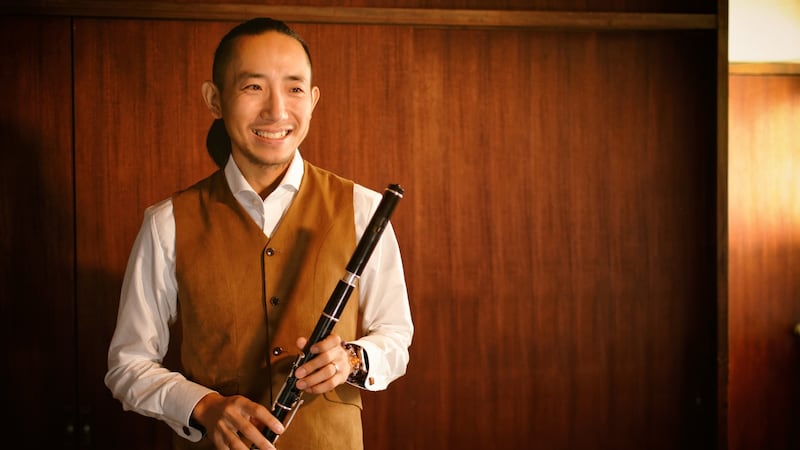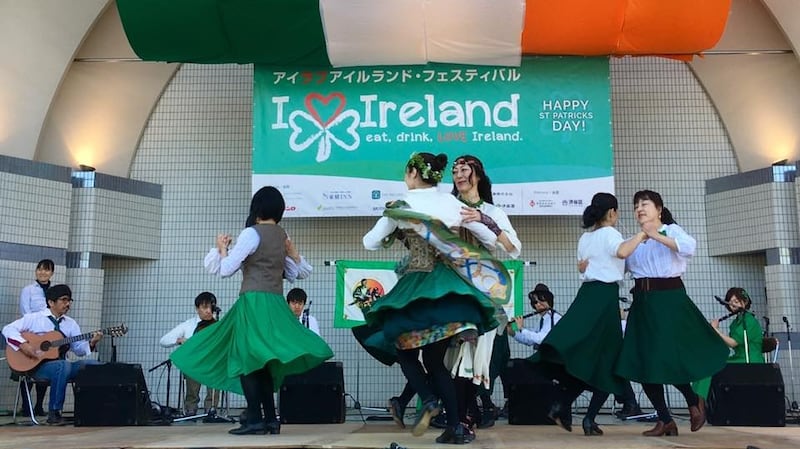As part of his practice regime for this month's Fleadh Cheoil in Drogheda, Taro Nagata hauls his fiddle up into the Alps in Nagano Prefecture in central Japan.
On top of Mt Utsukushigahara, at over 2,000m, the 27-year-old musician takes out his fiddle and starts playing The Connaught Man's Rambles. For Nagata's Irish music adventures, which he posts videos of on YouTube, he has also taken his tin whistle into a nearby lake.
Playing with the Alps looming on the horizon is easier for him than organising to play with the nine other members of Toyotaro Céilí Band, who are strewn across Japan.
A parish céilí band they are not but, come Sunday August 19th in the Dome in Drogheda, they’ll be representing the extended parish of Japan and its small but dedicated subculture of Irish trad musicians at this year’s Fleadh Cheoil na hÉireann.
To get there, the Toyotaro Céilí Band first had to qualify at Feile Tokyo, held annually in June and organised by Comhaltas in Japan, the music body's only outpost in Asia.
While only a few Japanese musicians make the pilgrimage to the Fleadh each year, they are part of a growing number of Japanese trad musicians and dancers whose ranks have been steadily increasing over the past decade.
In 2016 in Ennis the Toyota Céilí Band – no connection to the car manufacturers – made history by becoming the first Japanese and Asian Céilí band to play in an all-Ireland Fleadh. The audience in Ennis rewarded them with standing ovations.
For this year’s Fleadh, the rival Toyota Céilí Band and Taro Céilí Band have merged to form the Toyotaro Céilí Band. What’s striking about it is its all-Japanese line-up. It’s not that no Irish need apply –more a case of not enough Irish to apply.
That a small but studious cohort of Japanese musicians has taken to the fiddle, flute, concertina and uileann pipes is not in itself surprising.
As Noel Kenny, a concertina player living in Achill Island and a frequent visitor to Japan, says, “There are people playing Irish trad music all over the world and, in this sense, Japan is no exception.”
Because of the distance – both physically and culturally – the Irish music scene in Japan has developed on its own terms. The craic is also . . . different.
College connection
Irish music has had a receptive audience in Japan for decades. The Chieftains have been touring here for almost as long they’ve been around, even inspiring a local group called The Lady Chieftains.
In the Field, an Irish pub in central Kyoto that holds weekly sessions, one wall is decorated with bodhrans inscribed with messages by musicians and groups that have passed through, including Altan, Lúnasa, Kila and Andy Irvine. In April, concertina player Noel Hill convened a workshop there before playing a concert at a temple in the city.

Japanese musicians have also been making reconnaissance and friendship missions to Ireland for years, particularly to festivals such as Willie Clancy Summer School and the Feakle Festival in Clare.
It’s hard to get a definitive number of how many people play Irish music here; certainly there’s no shortage of venues for sessions and gigs. Irish pubs in Japan run the gamut from being as Irish as Darby O’Gill to genuine yet quirky venues such Kyojin no Stew House in Ginza in Tokyo, run by Drogheda man Alan Fisher, or Woodnote, a small log cabin in the suburbs of Kyoto, which quite possibly has the largest extant collection of Irish trad CDs in any pub in the world.
But, by and large, the main drivers of Irish music are college students who become interested in Irish music at university clubs known here as “circles”, which play an outside role in university life.
Lisako Ní Chionnaith-Fukuda, a fiddle player living in Achill Island, recalls being “shocked” the first time she witnessed a pub session while in university in Kyoto.
“Every single musician was enjoying so much of every moment of it. Before that, music was pretty much equivalent to torture, as I was pushed by my father to learn classical violin by a strict teacher at the age of four.”
Kozo Toyota, a professional flute player and founder of the Toyota Céilí Band, and a Fleadh Cheoil veteran (this will be his seventh year playing in competition), has been organising the Intercollegiate Celtic Festival for the past 10 years.
My parents would accompany me on guitar, and my younger brother would join in playing with chopsticks on a bowl or a plate
Held in early spring, before the academic year starts, the festival attracted around 30 participants when it was first held a decade ago. This year’s festival brought more than 160 students together for several days of workshops, céilís and concerts, culminating in a St Patrick’s Day parade.
Toyota studied ethnomusicology at the University of Tokyo, but only became interested in Irish music in his final year. He comes from a family of musicians, but they never played together – owing to the range and styles of music they played. But when Toyota fell down the rabbit-hole of Irish music, it slowly drew his family in, resulting in family sessions.
“My parents would accompany me on guitar, and my younger brother would join in playing with chopsticks on a bowl or a plate,” he says.
“Irish music is closer to our daily life, it’s very special to me.”

Toyota joined The Chieftains on their 2017 tour in Japan. He’s also recorded music for Nintendo and NHK, Japan’s public broadcaster.
While he’ll be competing in the flute and the céilí bands competitions, for Toyota, the Fleadh is more about self-improvement and enjoyment than podium finishes.
“Recently the all-Ireland champions are amazing, and listening to them play is very important for my own playing.”
The Fleadh is about friendship, Toyota says. He’s particularly looking forward to the Monday night after competitions are over, when “a lot of the tourists are gone and only the good musicians are left”.
Dedication
A major milestone for Irish music here has been establishing Féile Tokyo, from which musicians can qualify for the Fleadh in Ireland. Although Comhaltas Ceoltóirí Éireann Japan was first established in 1991, Féile Tokyo has only been running since 2016, supported by the Irish Government and the Irish Embassy in Tokyo.
But it’s the combined effort of the 60 members -– musicians and dancers – of CCÉ Japan that have brought Tokyo and Japan into the global Irish music community.
Fiddle player Oisín Mac Diarmada and dancer Samantha Harvey have been making the trip from Ireland to Féile Tokyo for the past three years for “an extended weekend” as adjudicators and mentors.
“The standard is really great. For quite a few years now there’s been Japanese musicians and dancers coming over to Ireland attending the summer schools,” Mac Diarmada says.

“In a way they’ve put in the footwork on learning the music on a deep level. They’re building their own scene in Japan to a very healthy place. When it gets to that point to some extent, it’s self-sustaining.”
Rieko Yamashita, a dancer and chairperson of CCÉ Japan, believes the “Celtic circles” that have popped up on campuses across Japan are a great opportunity for expanding Irish culture, especially because “Ireland is not well-known in Japan”.
Clock vs craic
Mikie O’Shea, from Naad in north Cork, is one of the few Irish trad musicians in Japan. The Irish community here is small – about 1,000 in a country of more than 125 million.
O’Shea, who has been living in Tokyo since 2016, runs fiddle workshops a few times a year, and also slots in with the Toyota Céilí Band. Before moving to Japan, he lived in Dubai, and had no idea there was an Irish music scene here until he arrived.
Certainly there's a lot less drinking at sessions. If there a session from seven to nine, it'll start at seven and finish at nine
“I landed down into An Solas (in Shibuya) and there was a big session on. It was all Japanese and the standard was fairly high. It was great,” O’Shea recalls.
Hailing from Sliabh Luachra, O’Shea has been busy imparting slides and polkas at his workshops and in sessions. Although he grew up playing Irish music, he’s mindful not to impose himself at sessions in Japan.
“Certainly there’s a lot less drinking at sessions,” O’Shea says, and the clock comes before craic. “If there a session from seven to nine, it’ll start at seven and finish at nine, and even if the craic is ninety and the music is going really well and you’re loving it, it stops at nine.”
Perhaps the members of the Toyotaro Céilí Band, with no trains to catch, will be able to hang back for a few more tunes while in Drogheda.
In the meantime, fiddle player Taro Nagata has one more thing he needs to brush up on before departing for Drogheda with the Toyotaro Céilí Band: a cupla focal. He hopes to be on stage in the Dome on All-Ireland Sunday, where he’ll get his chance to say: “Tá an-áthas orm an corn seo a glacadh.”
And if it happens, no doubt it’ll be up on YouTube.












